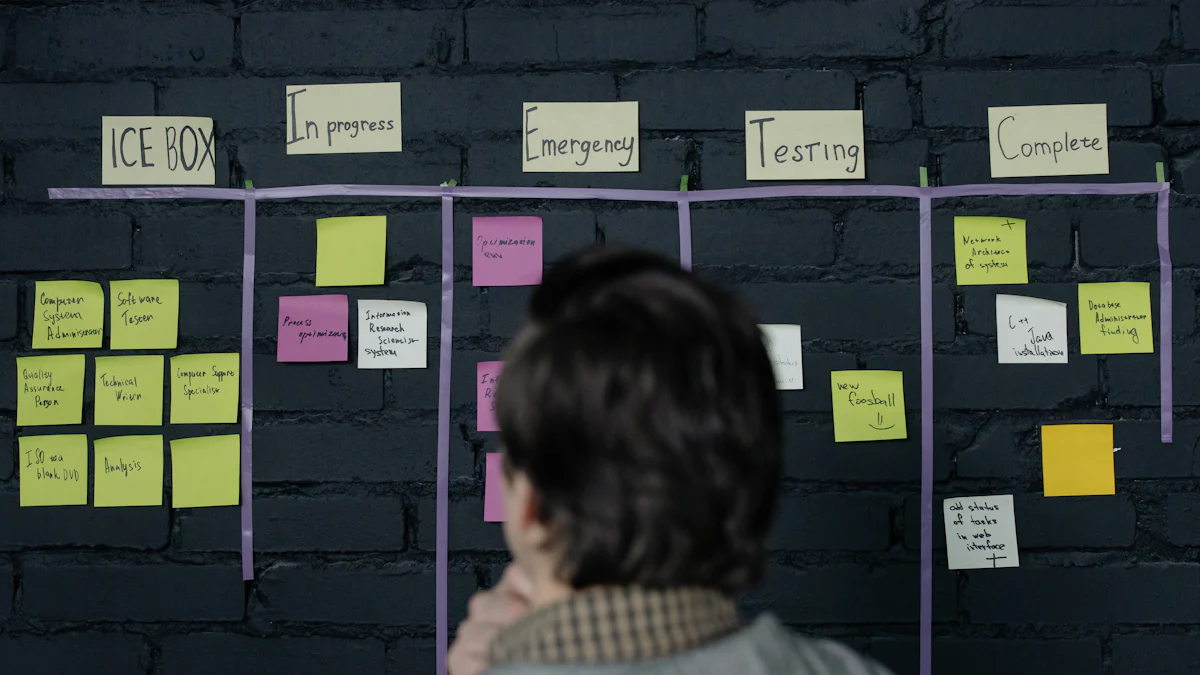Lean Agile Product Development Simplified for 2025

Lean agile product development combines the principles of lean thinking and agile practices to create efficient workflows that focus on delivering value to the customer. This approach emphasizes adaptability, collaboration, and continuous improvement. In 2025, businesses must adopt this methodology to stay competitive. Trends like DevOps, value stream management, and AI-driven agility highlight the growing importance of lean practices.
By merging lean and agile, you can streamline processes, reduce costs, and improve customer satisfaction. Teams deliver faster, avoid feature bloat, and align efforts with user needs. This ensures better products and stronger customer loyalty.
Key Takeaways
Focus on what customers need. Talk to them using surveys and feedback to make sure your product helps solve their problems.
Remove things that waste time. Find and stop tasks that don’t help, like too much paperwork or features no one uses.
Always try to get better. Set clear goals, try new ideas, and check your work often to improve how you do things.
Work together as a team. Let people from different groups share ideas and work together to create new solutions.
Use feature flags to test changes. This helps you try new features with small groups, get feedback, and fix things quickly.
Core Principles of Lean Agile Product Development
Focus on Customer Value
Lean product development starts with understanding what your customers truly need. You must identify the value they seek and align your efforts to deliver it. This principle ensures that every feature or product you create solves a real problem or enhances the user experience. Companies like Amazon and Tesla excel at this. Amazon’s Prime Membership and personalized recommendations have boosted customer satisfaction and loyalty. Tesla’s direct sales model and continuous software updates have created a strong connection with their users. These strategies demonstrate how focusing on customer value leads to better outcomes and long-term success.
To apply this principle, you should engage directly with your customers. Gather feedback through surveys, interviews, or analytics. Use this data to prioritize features that matter most. By doing so, you ensure that your development process remains customer-centric and avoids unnecessary distractions.
Eliminate Waste
Waste in lean product development refers to anything that doesn’t add value to the customer. Common examples include partially completed work, extra features, and task switching. These inefficiencies slow down progress and increase costs. For instance, defects in software require additional testing and fixes, while excessive documentation can delay delivery.
To eliminate waste, you need to map your value stream. Visualize each step in your development process to identify bottlenecks and inefficiencies. Focus on creating flow by removing delays and unnecessary tasks. This approach not only speeds up delivery but also ensures that your resources are used efficiently. Lean development emphasizes simplicity and agility, making it a superior alternative to traditional methods.
Continuous Improvement
Continuous improvement is at the heart of lean product management. It involves regularly refining your processes to achieve better results. You can start by setting specific, measurable goals for improvement. Align these goals with your business objectives to ensure they drive meaningful change.
Encourage your team to experiment and innovate. Create a safe environment where they can test new ideas without fear of failure. Regular feedback loops, such as sprint reviews and retrospectives, help you identify areas for growth. Provide training and mentorship to support your team’s development. Track progress using performance metrics and adjust your strategies as needed. This iterative approach ensures that your team evolves alongside your product, delivering consistent value to your customers.
Cross-functional Collaboration
Cross-functional collaboration is essential for lean agile product development. It brings together diverse expertise to solve problems and create value. When teams from different departments work together, they can align their efforts toward shared goals. This approach ensures that every aspect of the product, from design to delivery, meets customer expectations.
Successful examples of cross-functional collaboration include:
New product development, where design, engineering, marketing, and operations collaborate to create well-rounded products.
Project management, which ensures clear objectives and avoids duplicate work.
Customer service teams sharing insights to guide product development and marketing strategies.
Employee engagement initiatives that identify common themes to improve satisfaction.
Cost reduction efforts, where teams evaluate vendor contracts and find automation opportunities.
History also highlights the power of collaboration. Thomas Edison worked with a diverse team of specialists to invent the lightbulb. IKEA integrates efforts across departments to achieve sustainability goals. These examples show how collaboration drives innovation and efficiency.
To foster collaboration, you should encourage open communication and shared accountability. Use tools that promote transparency, such as project management software or regular team meetings. By breaking down silos, you can create a culture where every team member contributes to the product's success.
Iterative Development and Feedback Loops
Iterative development cycles are a cornerstone of lean agile product development. This approach involves building products in small increments and refining them based on feedback. It allows you to adapt quickly to changes and deliver value faster.
Feedback loops play a critical role in this process. Regularly reviewing feedback helps you identify patterns and actionable insights. You can prioritize improvements that enhance user satisfaction and engagement. For example, creating small pull requests enables faster feedback cycles and quicker problem detection.
Transparency is another benefit of iterative development. Communicating progress to stakeholders keeps everyone aligned and maintains momentum. Celebrating successes and learning from failures during iterations fosters a culture of continuous improvement. Gathering user input through surveys, analytics, or interviews ensures that your product evolves to meet customer needs.
By embracing iterative development cycles, you can reduce risks and improve efficiency. This method ensures that each iteration brings you closer to delivering a product that truly resonates with your audience.
Step-by-Step Guide to Lean Product Development
Specify Value for Customers
The first step in lean product development is to define what value means to your customers. This ensures that your efforts align with their needs and expectations. Start by understanding your customers' pain points and desires. Use a "market back" approach to validate that your product meets market demands before development begins. This method helps you avoid investing in ideas that may not succeed.
Follow these steps to specify value effectively:
Identify what your customers truly need.
Align your product development process with these needs.
Validate ideas quickly and discard those that fail.
Focus on delivering the right product at the right time.
By prioritizing customer value, you ensure that your lean product development initiative remains focused and impactful.
Identify and Focus on the Value Stream
A value stream represents the series of steps required to deliver value to your customers. Mapping this stream helps you identify inefficiencies and areas for improvement. Instead of focusing solely on resource efficiency, optimize the flow of work across departments. This approach ensures that every step in the process contributes to delivering value.
To enhance your value stream:
Involve cross-functional teams to gather diverse perspectives.
Keep an open mind to new ideas during future state mapping.
Start with small, impactful changes to build momentum.
Use metrics like lead time to measure progress.
Revisit workflows regularly as your organization evolves.
This focus on the value stream ensures that your lean development efforts remain agile and adaptable.
Create Flow by Eliminating Waste
Creating flow involves removing obstacles that slow down your development process. Waste in lean product development includes overproduction, excessive documentation, and task switching. By eliminating waste, you streamline workflows and improve efficiency.
Examples of successful waste elimination include:
Spotify's use of cross-functional teams to adapt quickly to feedback.
Toyota's lean manufacturing practices that maximize value.
ING's validation of innovations with customers to allocate resources effectively.
Reducing waste also boosts team morale by allowing them to focus on meaningful work. This approach aligns with lean principles and ensures that your resources are used effectively.
Respond to Customer Pull
Responding to customer pull means aligning your product development process with actual customer demand. This approach ensures that you deliver value exactly when and where it is needed. To achieve this, you must first understand what your customers truly value. Conduct interviews, surveys, or direct observations to gather insights. Tools like personas and customer journey maps can help you refine your understanding of different customer segments.
Once you identify customer demand, adjust your workflows to meet it. Implement systems like takt time to synchronize production with demand. This ensures a steady flow of value without overproduction or delays. Continuous feedback loops play a critical role here. Regularly collect feedback from customers to adapt quickly to their changing needs. This reduces waste and enhances process efficiency.
For example, in lean product development, you might release a feature to a small group of users and gather their feedback. Use this data to refine the feature before a full rollout. This iterative development cycle allows you to respond to customer pull effectively while minimizing risks. By focusing on customer demand, you ensure that your lean development efforts remain customer-centric and efficient.
Pursue Perfection Through Repetition
Pursuing perfection involves continuously refining your processes and products. In lean product development, this means striving for excellence through repeated iterations. Each iteration brings you closer to delivering a product that meets customer expectations.
Start by analyzing your workflows to identify areas for improvement. Use metrics like lead time or cycle time to measure efficiency. Encourage your team to experiment with new ideas and learn from failures. Regular retrospectives can help you pinpoint what works and what doesn’t. This fosters a culture of continuous improvement.
Lean product management emphasizes the importance of repetition. For instance, you might refine a feature multiple times based on user feedback. Each refinement improves the feature’s value and usability. Over time, these small improvements lead to significant gains in product quality and customer satisfaction.
By pursuing perfection through repetition, you align your lean product development initiative with the principles of lean. This ensures that your team delivers consistent value while adapting to changing market demands.
Common Pitfalls in Lean Agile Product Development and How to Avoid Them
Overcomplicating Processes
Overcomplicating processes often derails lean development. Teams sometimes rebrand simple concepts into complex frameworks or rely on excessive jargon. This creates confusion and slows progress. For example, Agile practices like sprints and stand-ups aim to boost productivity. However, too many meetings or fragmented focus can reduce deep work and efficiency. Similarly, overproduction, such as creating reports no one uses, adds unnecessary steps to the development process.
To simplify, focus on solving real problems. Streamline workflows by identifying and removing non-value tasks. Avoid excessive documentation and delays in approvals. Instead, prioritize clear communication and efficient decision-making. By keeping your processes straightforward, you align with lean principles and ensure your team stays focused on delivering value.
Lack of Team Alignment
A lack of alignment within your team can lead to stalled growth, lower customer satisfaction, and reduced employee engagement. Misaligned goals often result in wasted efforts on tasks that do not contribute to the value stream. For instance, poor communication between departments can cause delays or duplicate work, disrupting the development process.
To improve alignment, establish a clear vision that everyone understands. Foster collaboration by encouraging open communication and shared accountability. Centralize resources to ensure all team members have access to the tools and information they need. Regular check-ins and progress updates can also help maintain alignment. When your team works cohesively, you create a smoother workflow and deliver better results.
Ignoring Customer Feedback
Ignoring customer feedback undermines the core principles of lean product management. Without input from users, you risk developing features that do not meet their needs. This wastes resources and delays the delivery of valuable solutions. For example, failing to validate your product with real users can lead to costly redesigns later.
To avoid this pitfall, involve users throughout the development process. Use techniques like journey mapping and Voice of the Customer to understand their needs. Launch a Minimum Viable Product (MVP) to gather feedback early. Implement robust data analytics to track user behavior and make informed decisions. By prioritizing customer input, you ensure your product aligns with market demands and delivers meaningful value.
Failing to Adapt to Change
Failing to adapt to change can derail even the most well-planned lean agile initiatives. In today’s fast-paced market, businesses must remain flexible to survive. Sticking to outdated methods or ignoring emerging trends often leads to missed opportunities and declining relevance.
Several companies serve as cautionary tales:
Nokia: Once a mobile technology leader, Nokia failed to embrace the smartphone revolution. Its reluctance to prioritize software innovation caused a sharp decline in market share.
Kodak: Despite inventing digital photography, Kodak clung to its film business. This decision led to bankruptcy in 2012.
Blockbuster: Ignored the rise of streaming services like Netflix. Its inability to pivot resulted in its downfall.
JCPenney: Early online initiatives showed promise, but the company struggled to stay relevant in the retail market.
IBM: Lost its edge in personal computing by failing to innovate consistently.
Tower Records: Could not compete with digital music and illegal downloads, leading to closure in 2006.
These examples highlight the importance of staying agile. You must monitor market trends and customer needs continuously. Use data analytics to identify shifts in demand. Encourage your team to experiment with new ideas and technologies. Regular retrospectives can help you assess what works and what doesn’t.
Tip: Build a culture that embraces change. Reward innovation and adaptability to keep your team motivated.
By staying flexible, you can avoid the pitfalls of stagnation. Lean agile principles thrive on adaptability, ensuring your business evolves with the market.
Misunderstanding Lean and Agile Principles
Misunderstanding lean and agile principles often leads to ineffective implementation. Many teams confuse these methodologies with rigid frameworks or shortcuts. This misinterpretation undermines their potential to deliver value.
Lean focuses on eliminating waste and maximizing customer value. Agile emphasizes iterative development and collaboration. Combining these principles requires a clear understanding of their goals. For example, some teams mistake agile for speed, rushing through development without proper planning. Others misapply lean by cutting costs at the expense of quality.
To avoid these mistakes, you must educate your team. Provide training on lean and agile concepts. Use real-world examples to illustrate their application. For instance, lean encourages you to map your value stream to identify inefficiencies. Agile promotes feedback loops to refine your product iteratively.
Note: Lean and agile are not one-size-fits-all solutions. Tailor them to your organization’s needs for the best results.
Encourage open communication to clarify misconceptions. Regularly review your processes to ensure alignment with lean agile principles. By fostering a shared understanding, you can unlock the full potential of these methodologies.
Real-World Examples and Success Stories in Lean Product Development

Case Study: Spotify's Lean Agile Transformation
Spotify's journey toward lean development has inspired organizations worldwide. The company adopted a unique Agile framework that emphasizes autonomy and collaboration. Teams, known as "squads," operate independently while aligning with the company's broader goals. This approach allows Spotify to innovate quickly and respond to customer needs effectively.
Spotify's transformation offers valuable lessons. Organizations should customize Agile practices to fit their specific needs. For example, Spotify tailored its Agile elements to foster creativity and speed. Business alignment is another critical takeaway. Spotify ensured that its IT and business teams worked together seamlessly, extending Agile principles beyond product development. Leadership support also played a vital role. Spotify's leaders championed the transformation, uniting the organization under a shared vision.
Lesson | Description |
|---|---|
Customization | Organizations should adapt Spotify-inspired Agile elements to their context. |
Business Alignment | The transformation must align business and IT beyond product development. |
Leadership Support | Strong leadership ensures a unified vision and successful Agile adoption. |
Case Study: Amazon's Iterative Product Launch
Amazon's success in lean product development stems from its commitment to iterative processes. The company frequently launches products in small increments, gathering feedback from customers at every stage. This approach minimizes risks and ensures that only valuable features reach the market.
One notable example is Amazon Prime. The service began as a simple two-day shipping program. Over time, Amazon expanded it based on customer feedback, adding features like streaming and exclusive deals. This iterative process allowed Amazon to refine Prime into a comprehensive offering that meets diverse customer needs. By focusing on small, continuous improvements, Amazon has maintained its position as a leader in lean development.
Lessons Learned from Industry Leaders
Many companies have successfully implemented lean development principles. PayPal transitioned to business agility in 2013, introducing Scrum teams and KPIs to measure success. This shift improved customer understanding and streamlined project management. Roche Korea embraced Agile in 2020, achieving a 30% sales increase by focusing on adaptability and patient-centered processes. AstraZeneca enhanced collaboration and transparency through Agile, boosting production levels.
These examples highlight the importance of adaptability and customer focus. You can learn from these leaders by prioritizing customer needs, fostering collaboration, and embracing continuous improvement. Lean development thrives when teams remain flexible and aligned with their goals.
The Role of Feature Flags in Lean Development
Feature flags have become a cornerstone of lean agile product development. They allow you to release features in a controlled and incremental way, aligning perfectly with lean principles like reducing waste, accelerating feedback, and continuous improvement.
Reducing Risk with Feature Flags
Feature flags help you manage risk during product development by enabling controlled feature rollouts. Instead of deploying a feature to all users at once, you can release it to a small group and monitor its performance. This approach minimizes the impact of potential issues.
Implement early access programs, canary releases, or beta testing to gather insights from specific user groups.
Gradually expand the rollout to larger audiences while observing system behavior and collecting feedback.
If a feature causes unexpected problems or receives negative feedback, you can simply turn off the feature flag. This allows you to roll back changes instantly without deploying new code.
Feature flags also let you deploy code without activating new features immediately. If issues arise, you can disable the feature quickly, avoiding full rollbacks. This flexibility ensures a safer and more efficient development process.
Accelerating Feedback Through Controlled Releases
Feature flags enable faster feedback by allowing you to test features with real users in controlled environments. Companies like Facebook, Netflix, and Google use feature flags to gather insights and iterate quickly.
Example | Description |
|---|---|
Gradual rollouts and experimentation with subsets of users for rapid iteration. | |
Netflix | A/B testing to optimize user experience based on real-world data. |
Managing experiments and responding quickly to user feedback. | |
Experimenting with UI changes and algorithms to enhance flexibility. |
By using feature flags, you can collect actionable data early in the development cycle. This accelerates decision-making and ensures that your product evolves based on user needs.
Minimizing Waste by Testing Features Incrementally
Feature flags align with lean principles by reducing waste through incremental testing. Instead of investing heavily in features upfront, you can validate their value in real-world conditions.
Roll out features incrementally to minimize risks associated with live updates.
Test features with actual users to ensure operational efficiency and reduce rework.
Use faster feedback cycles to refine features based on real-world data.
Feature flags also allow you to validate features early. This prevents unnecessary investments in ideas that may not deliver value. By focusing on what works, you save time and resources while delivering better outcomes for your users.
Tip: Tools like FeatBit make it easy to implement feature flags, helping you stay agile and customer-focused.
Feature flags empower you to build smarter, faster, and with less risk. They are essential for any team striving to embrace lean agile development.
Enabling Continuous Improvement with Real-Time Adjustments
Feature flags empower you to make real-time adjustments, ensuring your product evolves continuously. This capability aligns perfectly with lean agile principles, where rapid learning and constant enhancement are key. By toggling features on or off instantly, you can refine your product without disrupting the user experience.
Here’s how real-time adjustments drive continuous improvement:
Quickly Respond to Feedback: Feature flags let you act on user feedback immediately. If a feature underperforms, you can disable it and rework it based on insights.
Experiment Safely: You can test multiple variations of a feature with different user groups. This helps you identify what works best without risking the entire system.
Optimize Performance: Monitor feature performance in real time. Use data to make informed decisions and fine-tune your product for better results.
Reduce Downtime: Real-time toggling eliminates the need for lengthy deployment cycles. You can implement changes instantly, keeping your product agile and responsive.
Tip: Use feature flags to create a culture of experimentation. Encourage your team to test ideas and learn from outcomes. This approach fosters innovation and keeps your product ahead of the curve.
By leveraging real-time adjustments, you ensure your product stays aligned with customer needs. This method not only enhances user satisfaction but also strengthens your competitive edge.
Why FeatBit is the Best Feature Flag Tool for Lean Agile Teams
FeatBit stands out as the ultimate feature flag tool for lean agile teams. It combines simplicity, flexibility, and powerful capabilities to support your development process. Here’s why FeatBit is the ideal choice:
User-Friendly Interface: FeatBit’s intuitive design makes it easy for teams to implement and manage feature flags. You don’t need extensive technical expertise to get started.
Real-Time Control: Toggle features on or off instantly. This ensures you can respond to issues or feedback without delays.
Advanced Analytics: FeatBit provides detailed insights into feature performance. Use this data to make informed decisions and optimize your product.
Seamless Integration: FeatBit integrates effortlessly with your existing tools and workflows. This ensures a smooth adoption process for your team.
Scalability: Whether you’re a startup or an enterprise, FeatBit adapts to your needs. It grows with your team, making it a long-term solution for lean development.
Note: FeatBit aligns with lean principles by reducing risk, accelerating feedback, and minimizing waste. It empowers your team to deliver value consistently.
By choosing FeatBit, you equip your team with a tool that enhances agility and efficiency. It simplifies feature management, enabling you to focus on what matters most—delivering exceptional products to your customers.
Future Trends and Innovations in Lean Agile Development

AI and Automation in Product Development
AI and automation are transforming the way you approach lean product development. These technologies streamline your development process by automating repetitive tasks and generating valuable insights. This leads to faster idea development and improved product quality. AI tools can reduce time-to-market by up to 50% and cut costs by 30%. In drug discovery, timelines have been reduced by over half.
Impact Area | AI Contribution |
|---|---|
Time-to-market | Reduced by up to 50% |
Costs | Cut by 30% |
Drug Discovery | Timelines reduced by over half |
By integrating AI into your workflows, you enhance your ability to deliver value to customers efficiently.
Remote and Hybrid Team Collaboration
Remote and hybrid work models have become essential in lean product management. They offer flexibility and access to a diverse talent pool. However, they also present challenges. Remote work can lead to feelings of isolation, making it difficult to form personal bonds essential for trust and communication. To overcome this, you can implement innovative strategies like virtual team-building activities and recognition systems.
Synchronous communication allows for real-time conversations, enabling immediate feedback and problem-solving, which helps maintain project momentum.
Asynchronous communication supports flexibility, accommodating different time zones and schedules, thus ensuring continuous progress.
These strategies foster collaboration and ensure your team remains connected and productive.
Sustainability and Lean Practices
Sustainability is becoming a key focus in lean product development training. You can adopt eco-friendly technologies and sustainable project management practices to minimize waste and optimize resource utilization. For example, using cloud-based solutions with optimized energy usage and energy-efficient hardware can significantly reduce your environmental impact.
Practice Type | Description |
|---|---|
Eco-friendly technologies | Adoption of cloud-based solutions with optimized energy usage and energy-efficient hardware. |
Sustainable project management | Employing lean principles to minimize waste and optimize resource utilization in Agile project management. |
Green UX/UI design | Designing applications to encourage energy-saving behaviors, such as dark mode and power-saving settings. |
Sustainable testing practices | Integrating energy efficiency assessments into performance testing to lower environmental impact. |
By incorporating these practices, you contribute to a more sustainable future while maintaining an efficient value stream.
Emerging Tools and Technologies
New tools and technologies are transforming how you approach lean agile development. These innovations enhance efficiency, improve collaboration, and simplify workflows. By adopting the right tools, you can streamline your processes and deliver value faster.
Version Control Systems (VCS): Tools like Git, GitHub, and GitLab help you manage code changes effectively. They allow multiple developers to work on the same project without conflicts.
Integrated Development Environments (IDE): Platforms such as Visual Studio, Eclipse, and IntelliJ IDEA provide powerful features for coding, debugging, and testing. These tools boost productivity by offering a seamless development experience.
Agile Project Management Tools: Jira, Trello, and Asana help you organize tasks, track progress, and maintain team alignment. They ensure that your projects stay on schedule and meet customer expectations.
Continuous Integration/Continuous Deployment (CI/CD) Tools: Jenkins, CircleCI, and Travis CI automate the build and deployment process. These tools reduce errors and accelerate delivery.
Communication Tools: Slack, Microsoft Teams, and Zoom enable real-time collaboration. They keep your team connected, whether working remotely or in hybrid setups.
Documentation Tools: Confluence simplifies knowledge sharing and ensures that your team has access to critical information.
Testing Tools: Automated testing tools like Cucumber and xUnit help you identify and fix issues early. This ensures higher-quality products.
Code Review Tools: These tools streamline the review process, ensuring that your code meets quality standards.
AI and automation are also reshaping lean product development. They reduce inefficiencies by automating repetitive tasks and generating insights. This allows you to iterate faster and improve designs. Feature flags further enhance your workflow by enabling gradual rollouts and real-time adjustments. These tools ensure that your product remains stable and responsive to customer needs.
By leveraging these emerging technologies, you can stay ahead in the competitive landscape. They empower you to build smarter, faster, and with greater precision.
Lean Agile Product Development empowers you to deliver value efficiently while staying adaptable in a competitive market. By focusing on customer needs, eliminating waste, and fostering collaboration, you can create products that resonate with users and drive long-term success.
Key Takeaways for Successful Implementation
Key Principle | Description |
|---|---|
Customer Value | Lean product development focuses on delivering value to customers while minimizing waste. |
Market Research | Understanding customer needs through market research is crucial for product alignment. |
Feature Flags | Utilizing feature flags enables gradual feature releases, facilitating quick feedback and risk reduction. |
Continuous Improvement | Regularly reviewing work processes encourages small, impactful improvements over time. |
Collaboration | Open communication and shared goals among team members enhance efficiency and product quality. |
Why Start Small and Iterate?
Starting small and iterating allows you to:
Align with Customer Needs: Gather regular feedback to refine your product.
Enhance User Experience: Continuously improve features for better usability.
Encourage Experimentation: Test new ideas and innovate confidently.
Reduce Waste: Eliminate inefficiencies and optimize workflows.
Build Mutual Trust: Foster collaboration and shared goals within your team.
By embracing these principles, you can create a culture of learning and adaptability. Begin with manageable steps, refine your processes, and watch your team thrive in delivering exceptional products.
FAQ
What is the difference between Lean and Agile?
Lean focuses on eliminating waste and maximizing customer value. Agile emphasizes iterative development and collaboration. Combining both ensures efficient workflows, faster delivery, and customer-centric products. You align your team’s efforts with user needs while continuously improving processes.
How do feature flags support Lean Agile development?
Feature flags allow you to release features incrementally. You can test with small user groups, gather feedback, and make real-time adjustments. This reduces risks, minimizes waste, and accelerates learning. Tools like FeatBit simplify feature flag implementation for your team.
Can Lean Agile work for non-software industries?
Yes, Lean Agile principles apply to any industry. You can use them to streamline processes, eliminate inefficiencies, and focus on customer value. For example, healthcare, manufacturing, and education sectors benefit from iterative improvements and cross-functional collaboration.
How do you start implementing Lean Agile?
Begin by mapping your value stream. Identify inefficiencies and focus on delivering customer value. Use small iterations to test and refine processes. Foster collaboration among teams and prioritize continuous improvement. Start small, learn from feedback, and scale gradually.
Why is customer feedback critical in Lean Agile?
Customer feedback ensures your product meets real needs. It helps you prioritize features, refine designs, and avoid unnecessary work. Regular feedback loops align your development process with user expectations, improving satisfaction and reducing waste.
See Also
Excelling In Lean Product Development For Agile Teams
The Impact Of Lean Principles On Agile Development
Achieving Proficiency In Lean Agile Development Techniques
Using Lean Agile Methods To Optimize Resources Effectively
Enhancing Efficiency And Overcoming Challenges With Lean Agile

